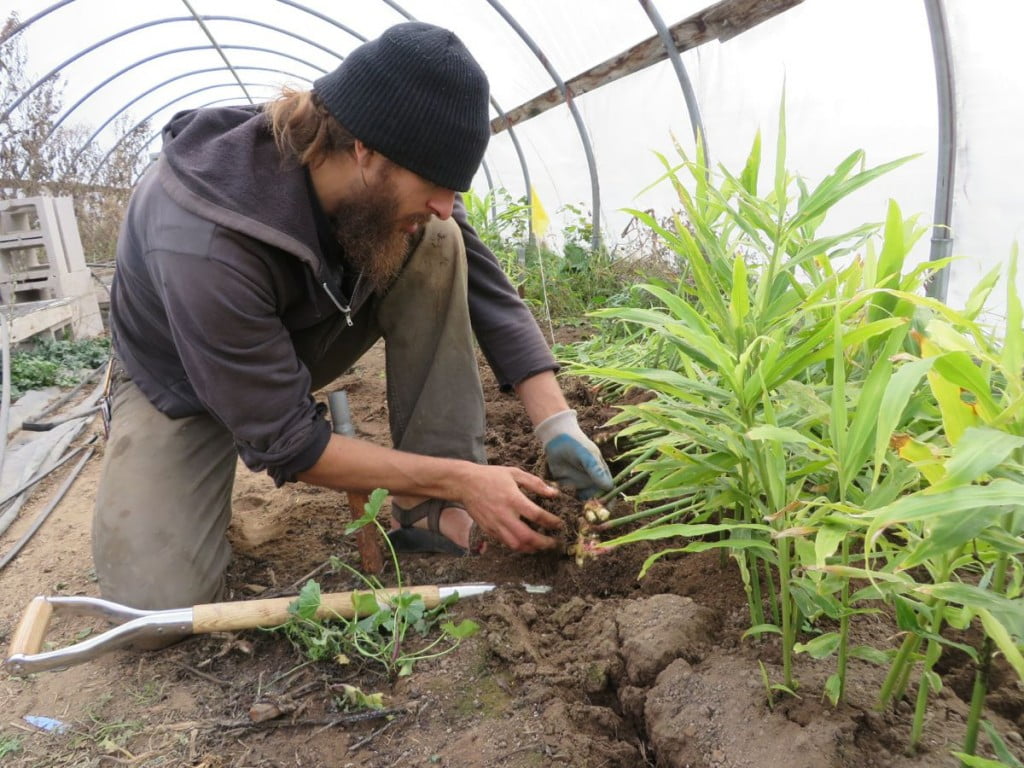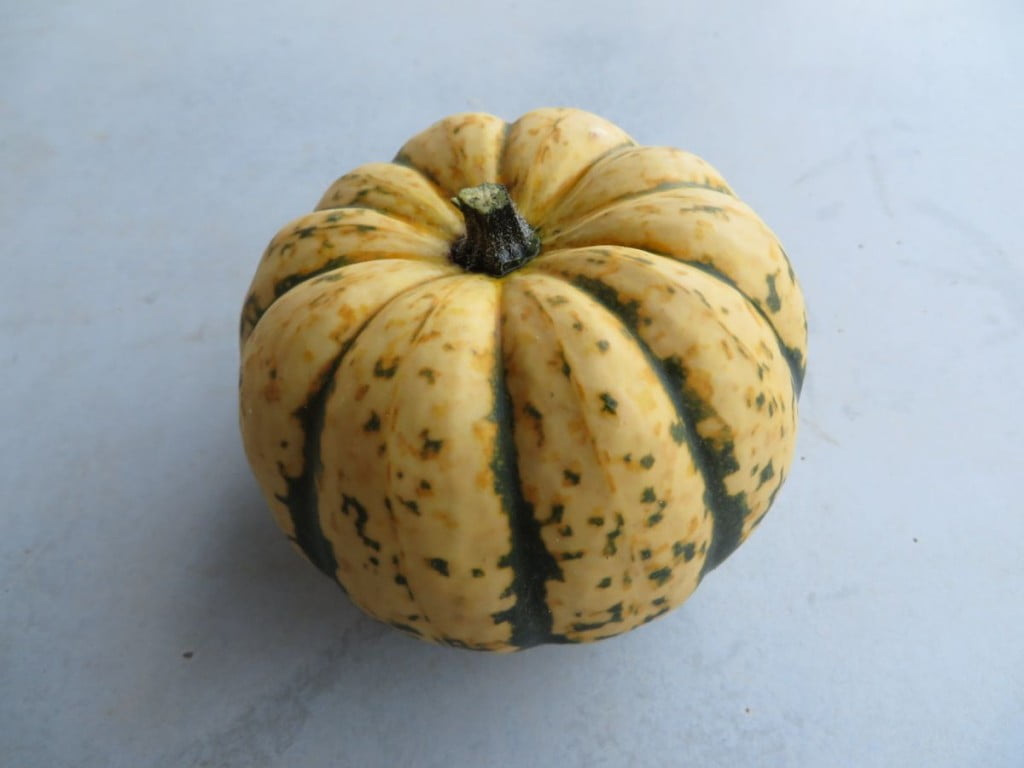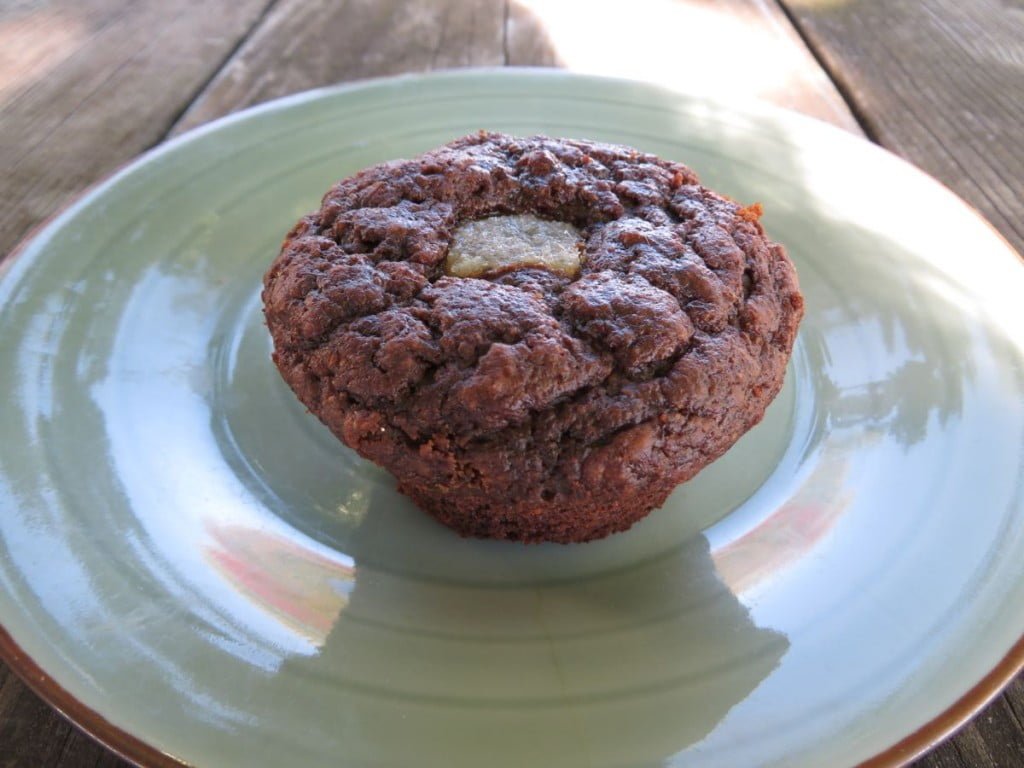Monthly Archives: October 2014
Something new, even now
- On: October 29, 2014
 0
0
We have something new to share, even this late in the season. We tried growing ginger in our smallest greenhouse. As a tropical crop, it needs the extra heat and shelter. Baby ginger is suddenly popular in the continental USA after a marketing campaign by Puna Organics, a Hawaiian farm that sells organically raised stock plants. That’s who we bought our cuttings from this year. The owner is quite colorful. Check out the Puna Organics website if you’re interested in guys with too many tattoos or women wearing coconut bikinis. We started the plants in March and they were finally ready to harvest this week. It was an experiment, so there’s just a bit to share with everyone this week. We’ll plant more next year so we can harvest enough for more than one delivery. It was a fun experiment!
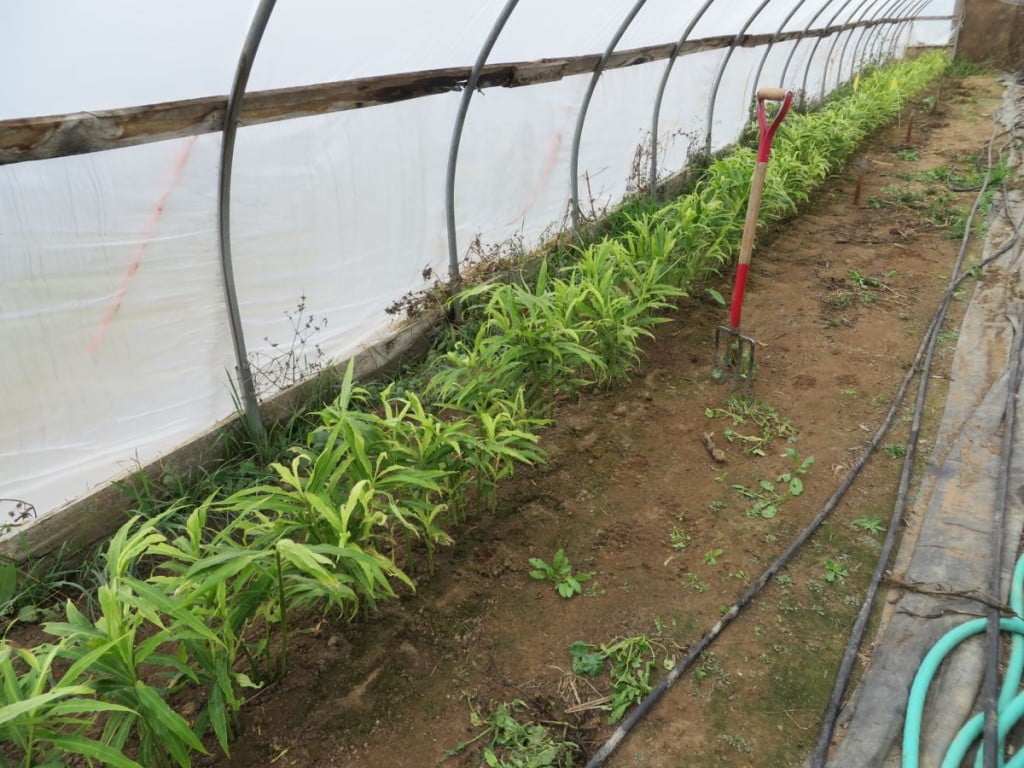
Ginger plants. This is our smallest greenhouse, one that we generally use for just six weeks in spring to acclimate plants to cool temperatures before they go outside. This house is a good choice for ginger because the sides roll up for ventilation during hot weather. Ginger is tropical but still doesn’t like temperatures over 90 oF.
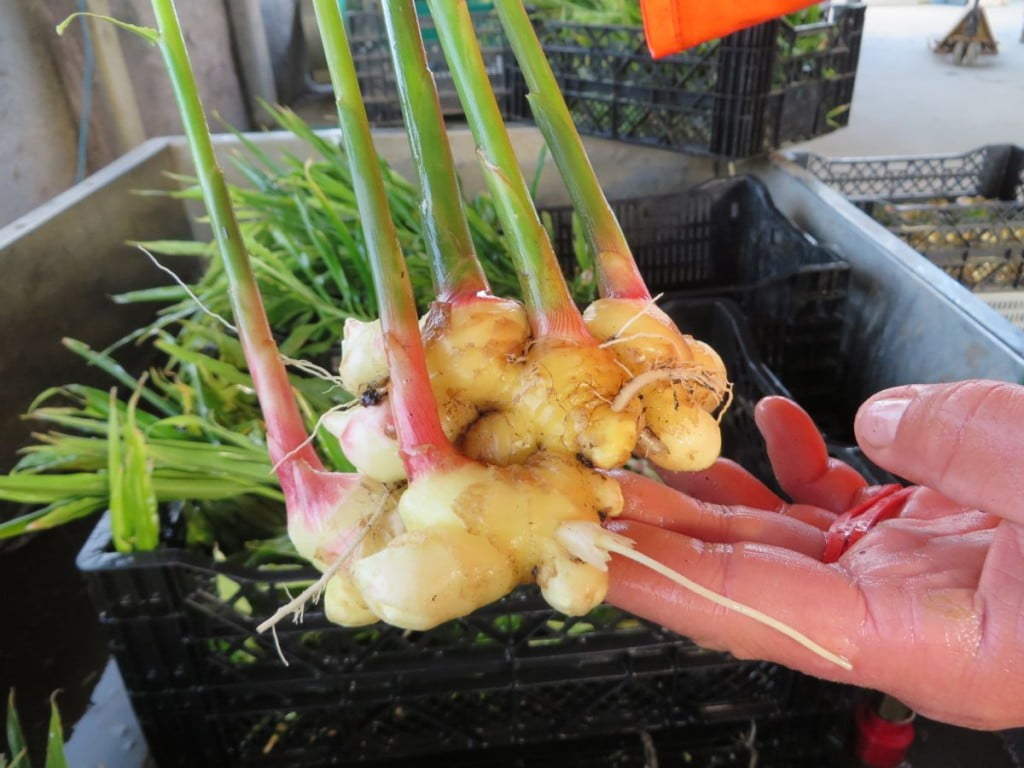
Isn’t it lovely? This ‘baby ginger’ has not yet developed the tan skin you see on ginger in the grocery store. That takes a longer growing season than we can achieve in Wisconsin. This is yellow ginger, more pungent than other ginger varieties.
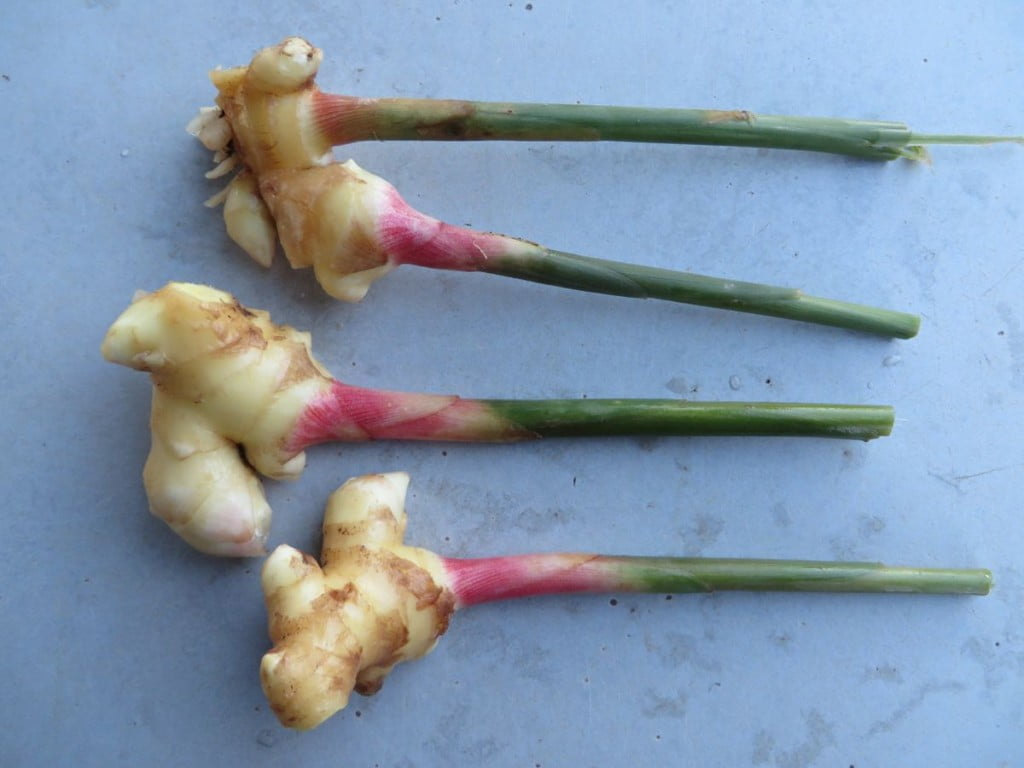
We cut it into small knobs so everyone could get a bit this week. It’s not much but we hope you enjoy it.
CSA countdown
November 6/7 (next week!) = final delivery for green EOW members.
November 13/14 = final delivery for weekly members and for purple EOW members.
Farm news
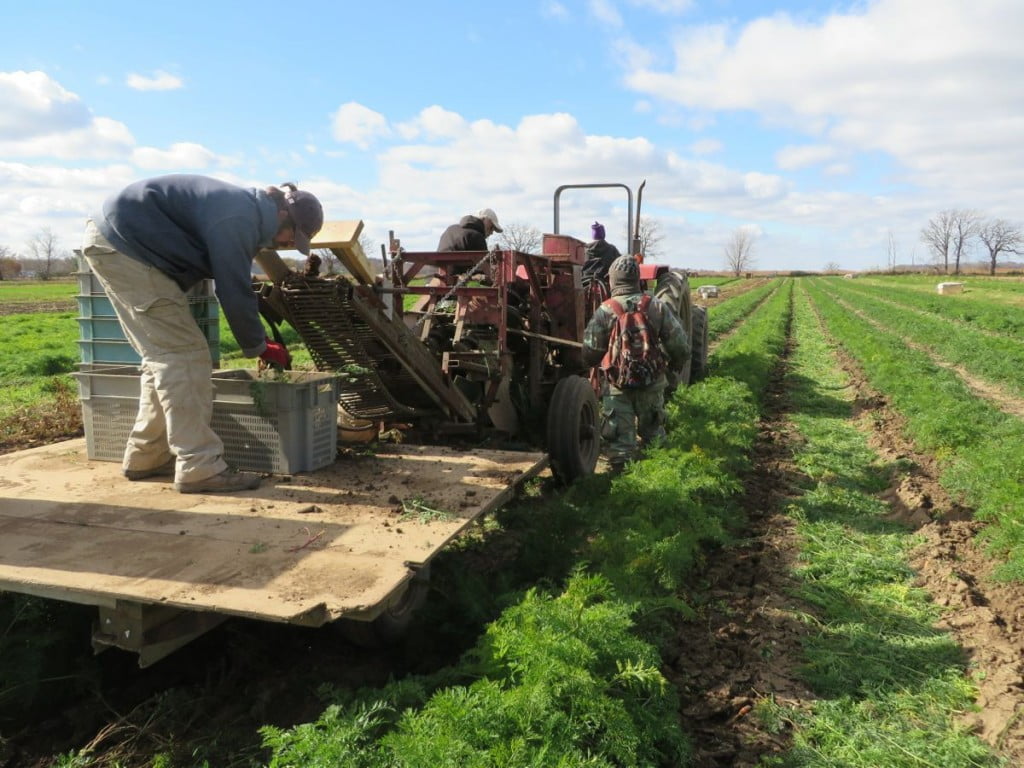
Carrot harvest continues. This looks like last week’s photo but now there are fewer rows of carrots.
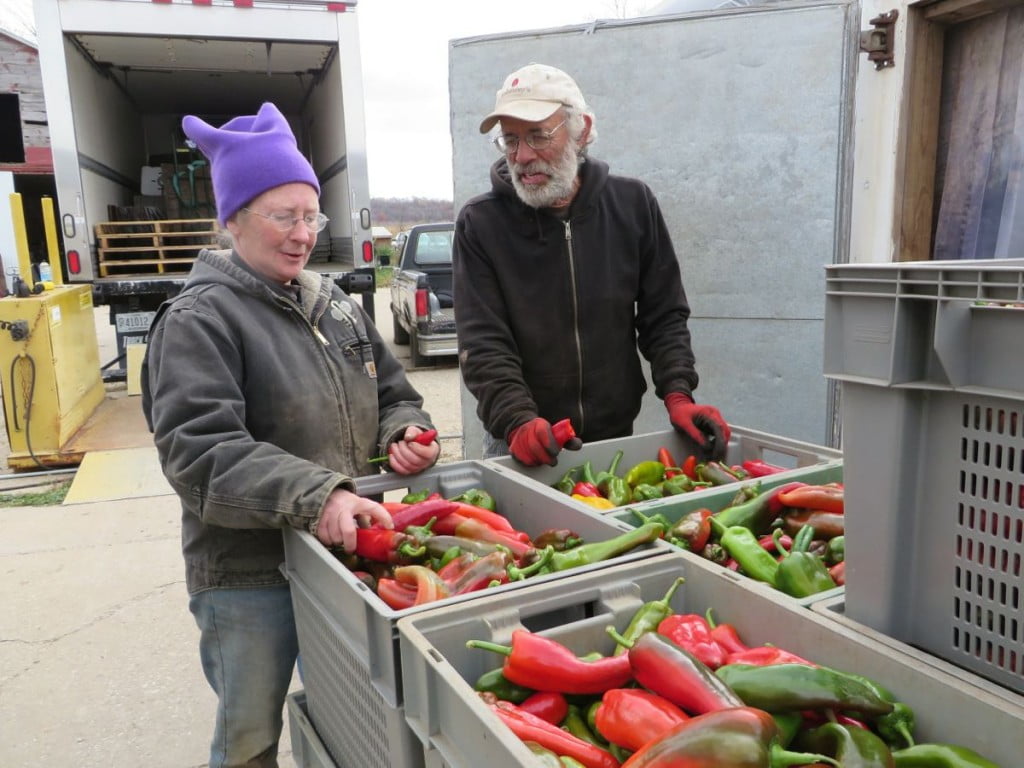
This week, we will strip the remaining peppers from the final pepper planting, the field Steve repeatedly saved from frost. Simone and Steve talk over the frying pepper varieties that we tested this year. The consensus: “Sweet Delilah” is a keeper, “Stocky Red” is a dud. Our longtime favorite “Carmen” is still the best.
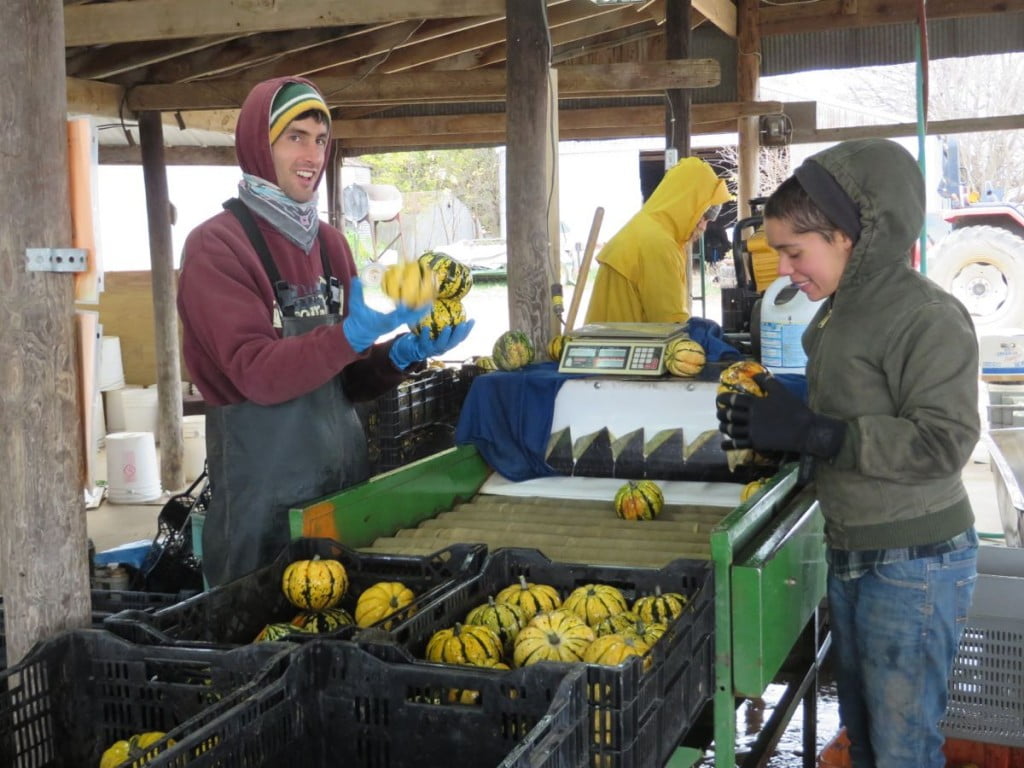
Jon, Jory and Boi wash the Sweet Dumpling squash you will receive this week.
Veggie list and veggie notes
Red cabbage
Sugar Dumpling squash, 2
(OR 1 Sugar Dumpling + 1 small butternut)
Broccoli, 1 or 2 heads
(A few members will get purple cauliflower instead)
Carrots, 2 lb
Frying peppers, about 4
Onions, 2
Garlic, 1
Baby ginger, 1 knob
Next week’s box will probably contain Brussels sprouts, butternut squash, celeriac, carrots, kale, scallions, and more.
Broccoli OR purple cauliflower – Only a few sites will receive purple cauliflower this week. Treat it like normal white cauliflower.
Baby ginger – Perishable. Use soon. Cover and refrigerate.
Sugar Dumpling squash – This is currently my favorite squash. We tested many winter squash varieties over the past few years. ‘Sugar Dumpling is one of the best. It looks like a Sweet Dumpling squash but is more substantial. Sweet, starchy, flavorful. We hope you enjoy them. Store at room temperature.
Winter squash hint: Sugar Dumpling and butternut can be difficult and dangerous to cut. Try microwaving your squash for 30 seconds to 2 minutes before cutting. It softens the squash and makes it easier to cut or peel.
Last chance to get a 2014 receipt.
- On: October 22, 2014
 0
0
Go to this link to send yourself a receipt for your 2014 CSA shares. I plan to dissemble this feature next week, so please send yourself a receipt now if you need one.
Host a new Tipi CSA site in 2015?
We are still looking for someone to host a new Tipi CSA site in the Madison area. If we find the right places, we might add two new sites. We are open to working in a member’s garage or in a workplace. Workplace sites are especially interesting because of the convenience they offer to members. Read more here, and contact us if you are interested.
Farm news and photos
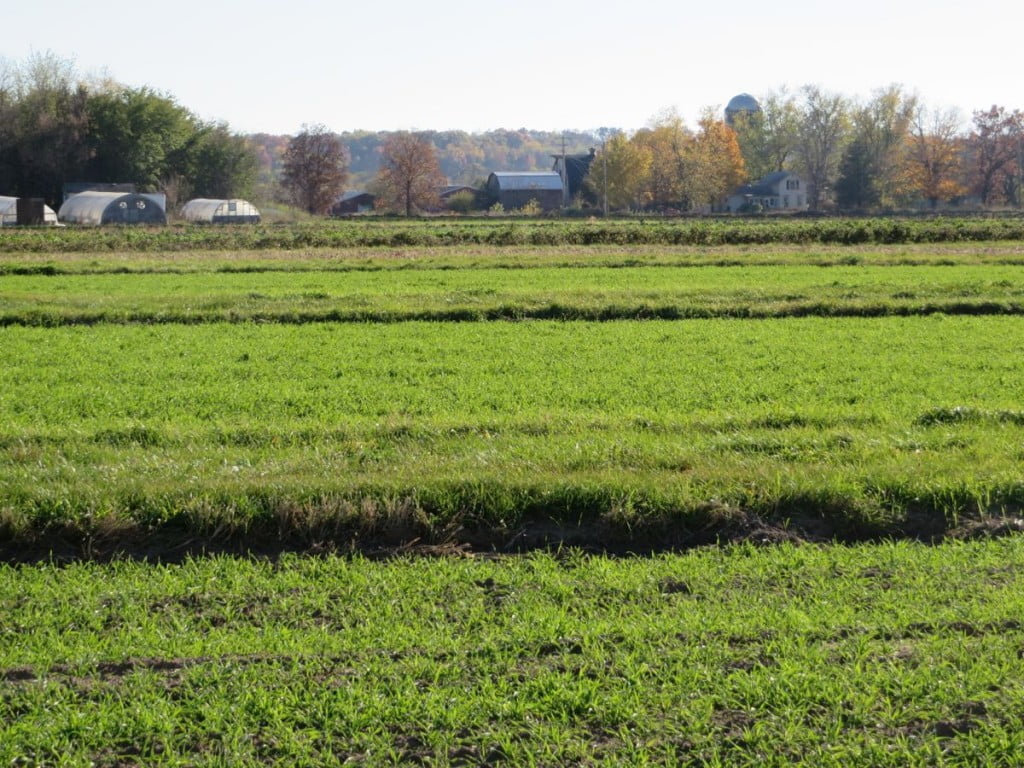
Would you believe me if I claimed this photo was taken in spring? Ha! The trees show the true season. Our cover crops are so lush right now.
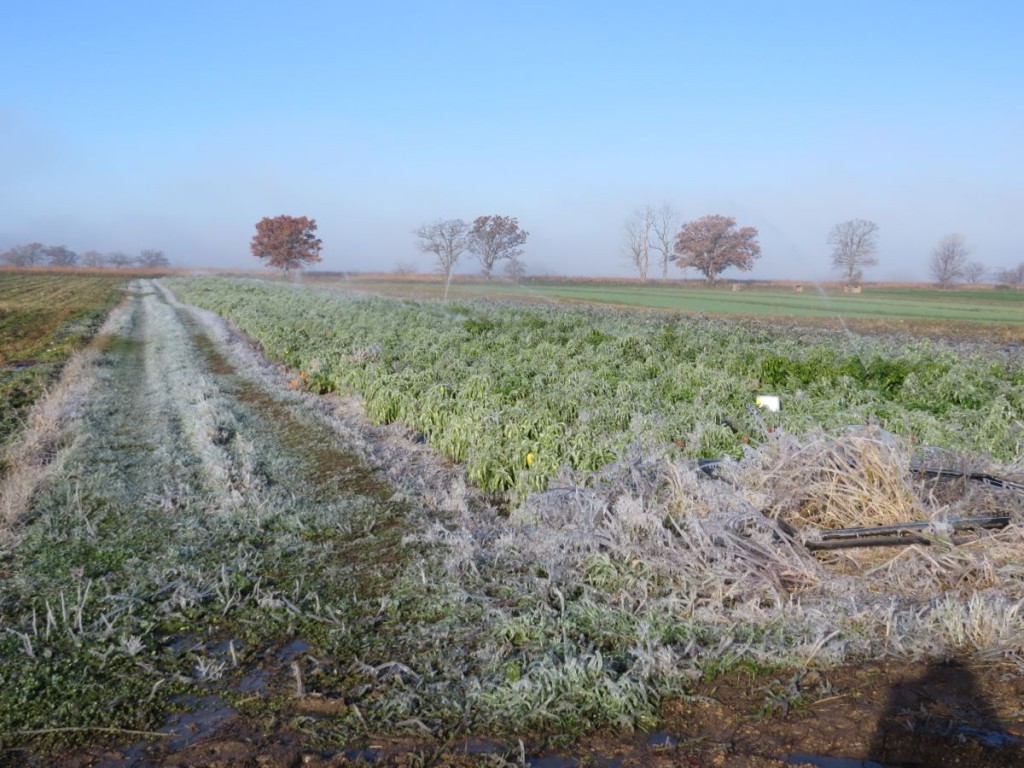
Steve has irrigated our pepper fields through all the frosts, including last night. Heat released as water crystallizes into ice keeps the plants at a steady 32 oF. Sounds crazy, but it works. That’s how we’ve had peppers for you during the last few weeks. Now we are down to one remaining pepper field. It is so difficult to let go.
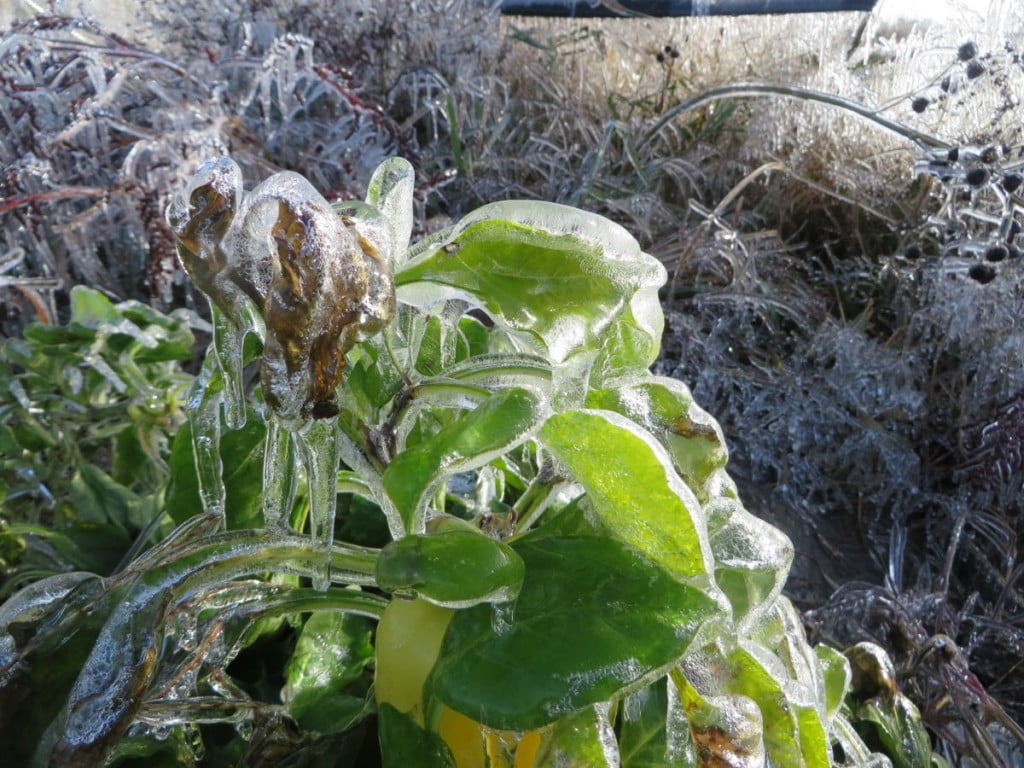
By this morning, the plants were coated with a thick layer of ice. See the yellow bell pepper under the leaves? It was perfectly fine once the ice melted.
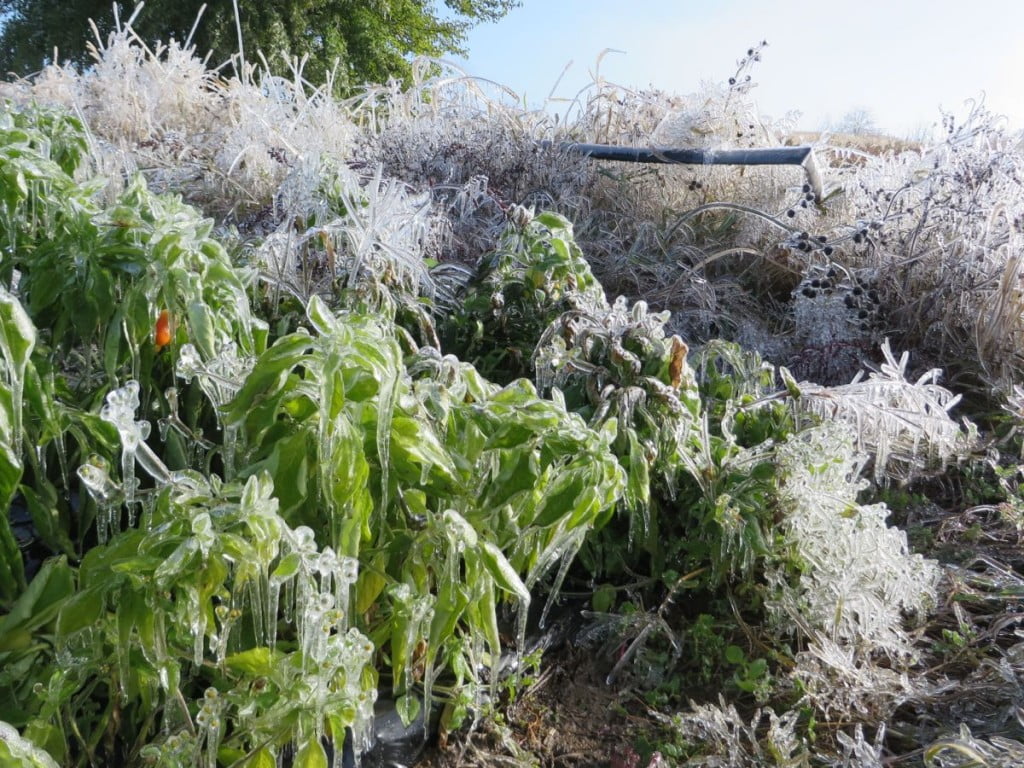
The ice can be gothic. How ironic – our last summer field was the only one covered in ice.
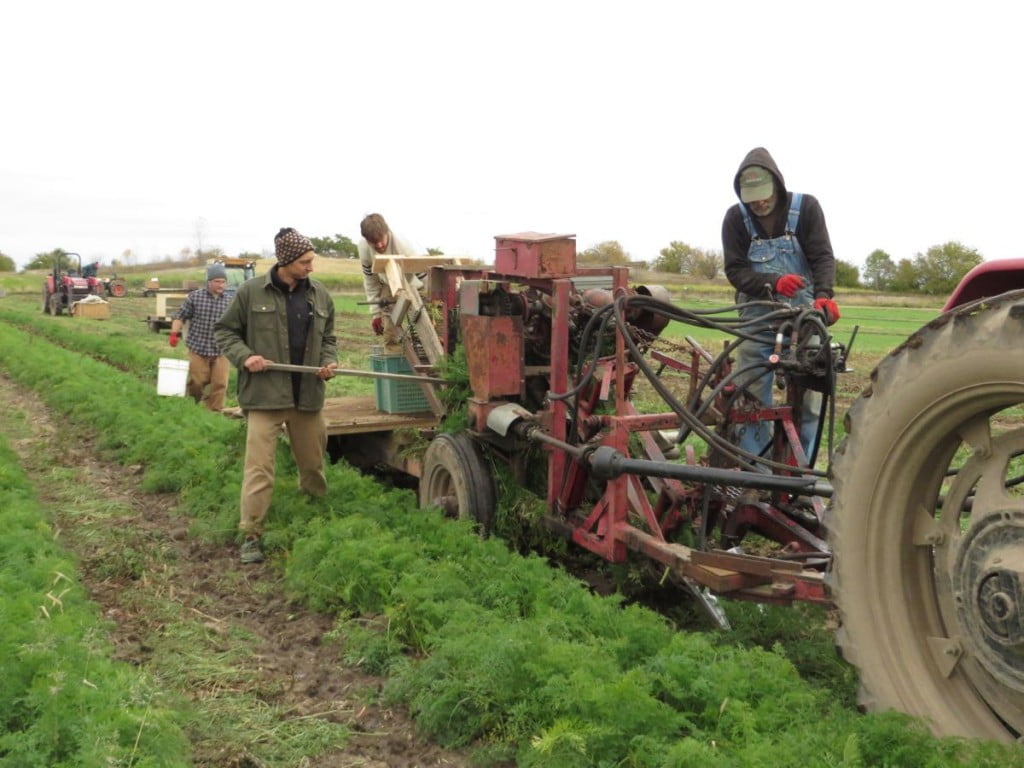
Carrot harvest is a team effort. From right, Steve steers the carrot harvester, Billy tends the harvested carrots, Tristan keeps the carrot tops flowing out of the harvester, and Joel picks up missed carrots. In the background, Larry and Michael haul bins of carrots back to the cooler. Simone is driving the tractor pulling the harvester, just out of the picture.
Our storage harvests are underway. The warm, dry weather is a gift. We are steadily stashing away celeriac, carrots, parsnips and turnips. We’ll start on cabbage and beets soon. These are important harvests for us. Steve is nervous as he goes over the preparations. “What if the harvester breaks? What if the cooler fails once it’s full?” This is very telling – Steve is not a nervous guy. We have so much riding on these storage crops, which we count on selling all winter. The big concern is that the weather will turn wet and we won’t be able to harvest the roots before the ground freezes. It’s been many years since we left carrots in the ground. That’s a virtue of our sandy soils. Beth
Veggie list and veggie notes
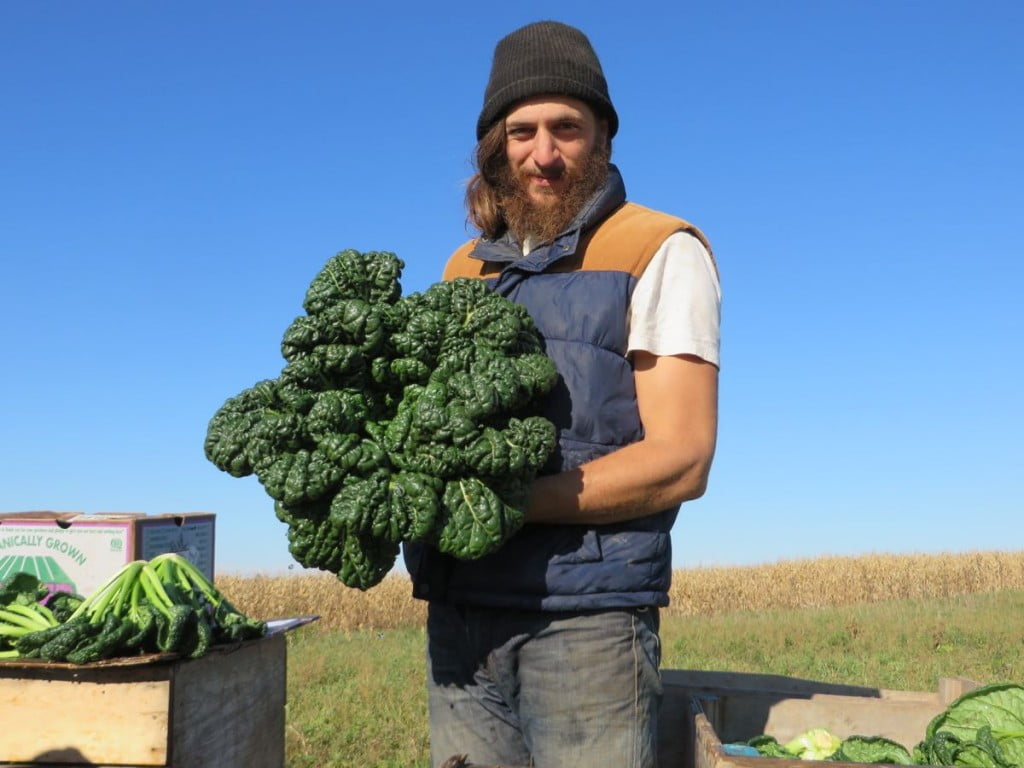
Don’t be frightened by the yukina. They look big but shrink substantially when cooked. Above, Clint holds a freshly harvested head of yukina.
Sweet potatoes, about 2 lb
Yukina greens, 1 large
Leeks, 1.5 – 2 lb
Russet potatoes, about 3.5 lb
Parsnips, 1.5 lb
Romanesco broccoli, 1 or 2 heads
Bell peppers, about 2
Onion, 1
Next week’s box will probably contain red cabbage, winter squash, broccoli, carrots, frying peppers, onions, garlic and more.
‘Beauregard’ sweet potatoes – Here are a few things we’ve learned about sweet potatoes:
– Store your sweet potatoes at room temperature. They suffer chilling injury below 50 F.
– The sweet potatoes we grow require slightly longer cooking than ones from the supermarket, perhaps because they contain higher moisture so soon after harvest. Cook thoroughly for best flavor and texture.
– Sweet potatoes are good at any size. We have cooked everything from tiny to jumbo and consistently find that all sizes taste good.
– We have a new favorite way to roast sweet potatoes. We used to prepare sweet potato fries. Now we just quarter the potatoes, rub with olive oil, dust with salt and place cut-side-down on a cookie sheet. Roast in a 450 F oven without turning until soft. The flavors will caramelize (like sweet potato fries) but preparation is simpler and the cooking time less exacting. Slender sweet potato fries go from undercooked to overcooked in the blink of an eye.
Parsnips (tapered, cream colored roots) – Those long, white roots are not carrots, they are parsnips. The two vegetables are related. When cooked, parsnips are sweet and starchy. For the best flavor, brown them to caramelize the sugars. Here are a few ideas for parsnip preparation:
– Caramelize the parsnips by roasting them in a vegetable medley.
– Parsnip fries are delicious: cut like French fries, coat very lightly with oil, place on a cookie sheet and roast in a hot oven until brown and cooked through.
– Try substituting grated parsnips in a potato pancake recipe. They brown beautifully and are very tasty.
– Steve loves pan-fried parsnips with onions and garlic.
Yukina (large heads of dark green leaves) – This is my favorite fall green. It is nutritious, delicious, a great combination of mustard-like leaves with crunchy stems. Personally, I think it’s a better ratio of leaves to stems than bok choy. These yukina look big, but the average weight is just 1.5 lb, which tells you they will shrink once cooked. We usually steam and drain chopped yukina, then dress it with a cooked mixture of fried garlic simmered with olive oil, balsamic vinegar, soy sauce, a little sugar and a lot of paprika or hot pepper flakes.
See below for an interesting way to prepare yukina in the oven.
Spicy Roasted Yukina (or bok choy)
This is an interesting way to tackle any voluminous tender green like yukina or bok choy. We made a batch and enjoyed it first as a hot dish, then as a cold salad.
1 large head yukina or bok choy
2 Tbsp. olive oil
1.5 Tbsp. sesame oil
4 Tbsp. soy sauce or tamari
1.5 Tbsp. rice vinegar
3 cloves garlic, minced
2 tsp. red pepper flakes (less if you don’t like spicy food)
2 Tbsp. toasted sesame seeds
1. Preheat oven to 400 oF.
2. Cut the yukina in half lengthwise. Cut stems and leaves into ribbons. Wash well and drain. Shake well to remove excess water.
3. Stir together all the remaining ingredients.
4. Spread the yukina on one (or two) large cookie sheets. Pour the marinate over the yukina and toss with your hands.
5. Roast until wilted and tender-crisp, about 10 – 12 minutes.
6. Toss again. Adjust marinade to taste. Serve.
Let’s review our schedule
- On: October 15, 2014
 0
0
We have four more CSA deliveries after this week:
October 16/17 (this week) – purple EOW
October 23/24 – green EOW
October 30/31 – purple EOW
November 6/7 – final box for green EOW members
November 13/14 – final box for weekly members and purple EOW members
We will contact our storage share members directly with the delivery date for that share. Our storage shares are sold out.
New Madison-area CSA site in 2015?
We would like to open one additional CSA site in the Madison area next year, in a neighborhood or a workplace. We are particularly interested in working with current Tipi members. Wouldn’t it be convenient to have your CSA box delivered directly to your neighborhood or workplace? Read more here, and contact us if you are interested.
Farm News
It’s been a wet week but we keep working, even when it rains.
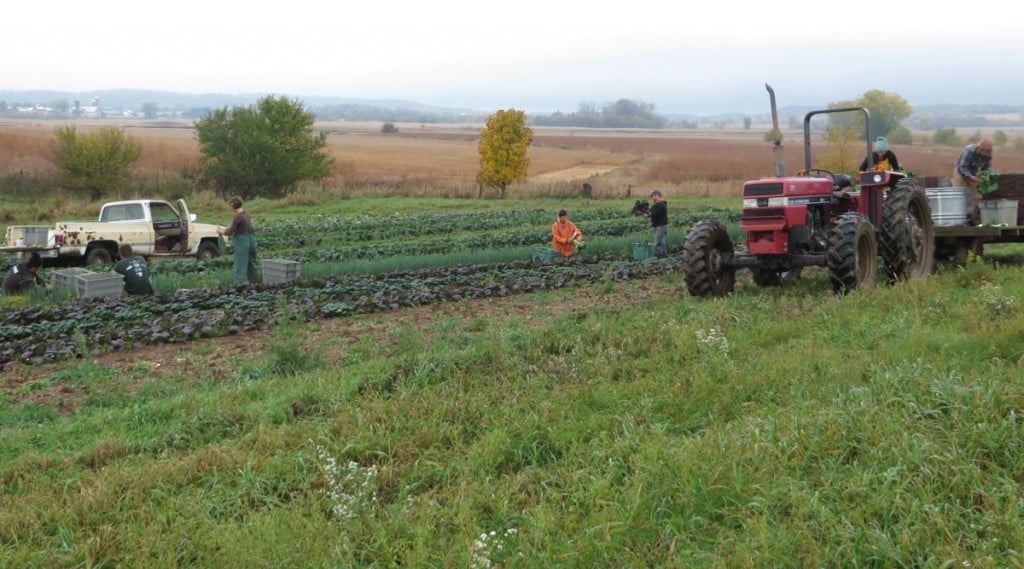
We hurried to complete our field harvests during the dry spells. From left, Mario, Tristan and Kerry harvest scallions, while Jon and Joel harvest bok choy. Bonnie and Michael wash the choy on the wagon. This field overlooks our neighbors’ soybean field and their large prairie planting.

Steve hopes it does not rain again until after Thanksgiving. Even our sandy soils turn to mud after 2.5 inches of rain.
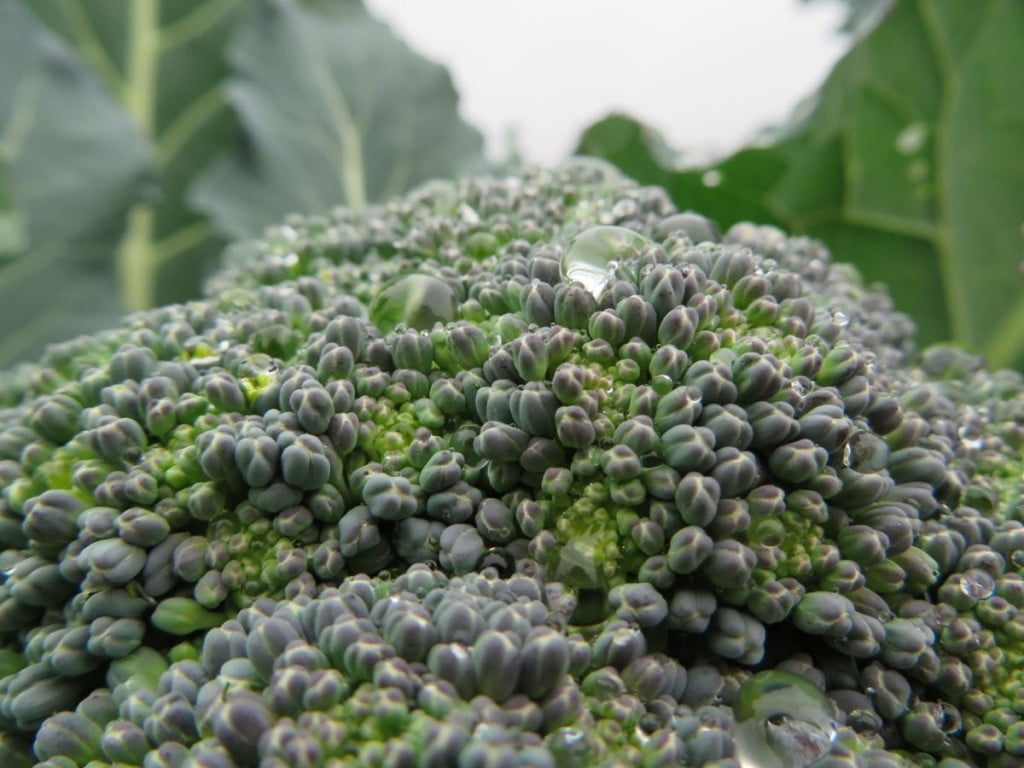
Good thing broccoli is waterproof.
Veggie list and veggie notes
We will pack mixed veggies that you can combine in Asian-style dishes; bok choy, daikon radish, scallions, garlic, ‘mild’ chiles with lots of flavor. You can stir-fry these these ingredients together, or make an excellent fresh kimchi salad. Steve points out that “every dish at a Chinese restaurant includes celery”, so perhaps you will add the celery to this list.
Bok choy, 1
Daikon radish, about 1 lb
Scallions, 1 bunch
Garlic
‘Mild’ habaneros, a handful
Cauliflower OR broccoli
Celery
Winter squash
Bell peppers, about 2
Yellow onions, 2
Next week’s box will probably contain sweet potatoes, Yukina greens, russet potatoes, peppers, Romanesco broccoli, onions, carrots, and more.
Bok choy – You will receive either red or green bok choy.
Daikon radish – Finally, we have daikon for you!
‘Mild habaneros’ – These ‘mild’ habaneros are pretty interesting. They do have heat, about the level of a typical Anaheim or poblano (not this year’s poblanos which are unusually mild). These habaneros are useful because you get manageable heat with really great flavor. We are sending about 4 per box.
Celery – You will probably want to cook this celery because it is strongly flavored, and has some insect scarring. We experimented with our one annual celery planting this year. We planted later than usual so it would mature in cool weather and be more tender than celery harvested during the summer. It sort of worked. This celery is more tender than in other years. However, planting later created more opportunity for insect attack. Look it over, taste it raw, and decide how you want to use it.
Winter squash – You will receive either butternut OR Sunshine OR acorn OR Sweet Dumpling. See below for photo ID and hints for cooking Sunshine squash.
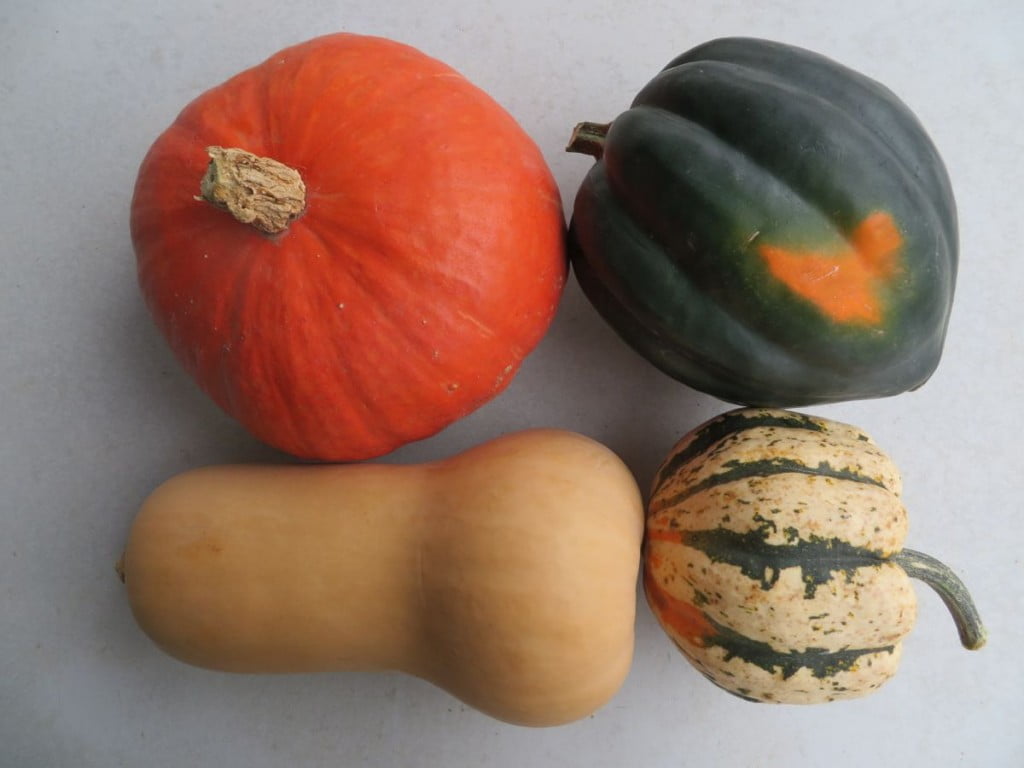
Squash ID. Clockwise from top left, Sunshine, acorn, Sweet Dumpling, butternut.
Notes on Sunshine squash
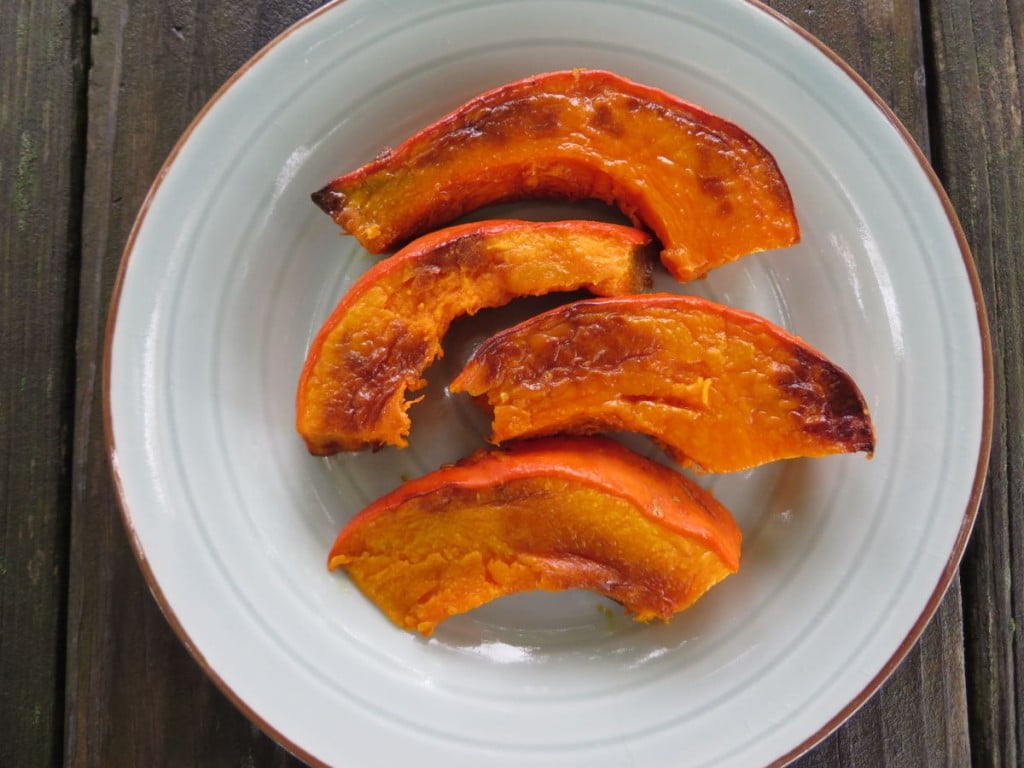
Roasted Sunshine squash slices
This is the first year we’ve had many Sunshine squash to distribute. These bright orange squash have a dry texture when cooked, with a mild, sweet flavor reminiscent of chestnuts. The skins are tender and edible. We find that Sunshine do not store well, probably because of the thin skins. Eat these soon. Like all winter squash, they are best stored at room temperature with good air circulation. On your kitchen counter is perfect.
Now that we finally have some to cook (!) I’ve settled on a favorite simple preparation. Dry roasting seems the best way to bring out their delicate flavor. Cut the Sunshine into thick slices, toss with olive oil, and roast on a well-oiled cookie sheet at 425oF until soft. The slices will fall apart if you overcook them but you have a fairly wide window to get them out of the oven successfully. You want to roast them until the cut surfaces are caramelized. Season with salt after they are out of the oven. Serve with a yogurt-garlic-olive oil dip. The skins are edible.
Squash (or Sweet Potato) Muffins with Candied Ginger
Adapted from Deborah Madison’s Vegetarian Cooking for Everyone.
Make 12 muffins.
Beth’s note: This is a great way to use leftover roasted winter squash or sweet potatoes.
1/2 cup candied ginger, dried cranberries or raisins, or a mixture
(plus extra candied ginger to top the muffins.)
1/4 cup vegetable oil
1/3 cup unsulfured molasses
1/2 cup packed brown sugar
1 cup mashed cooked winter squash or sweet potato
2 eggs
1/2 cup buttermilk (see substitution)
1 3/4 cup whole wheat pastry flour
1 tsp. baking powder
1 tsp. baking soda
1/2 tsp. salt
1 tsp. cinnamon
Preheat the oven to 375oF. Oil or spray your muffin tin.
Mix the ginger and wet ingredients in a bowl until smooth. Mix the dry ingredients together separately. Combine the two, and mix gently until well blended. Spoon the batter into the muffin tin. Top each muffin with a bit of candied ginger. Bake on the middle shelf until lightly browned, 25 minutes.
Soy substitution for the buttermilk: Mix 1/2 cup soy milk with 1 1/2 tsp white vinegar. Stir and let sit for 5 minutes.
Gleaning fun
- On: October 08, 2014
 0
0
The pumpkin and gleaning party was a big success. Members visited to enjoy the perfect weather, pick pumpkins and glean a few vegetables. There were loads of pumpkins to choose from; it was a strong, healthy crop this year. The day was very enjoyable for Steve and I, a chance to hang out with the people we’ve fed all year. I’ve posted additional photos on our Facebook page, labelled #tipiglean14.
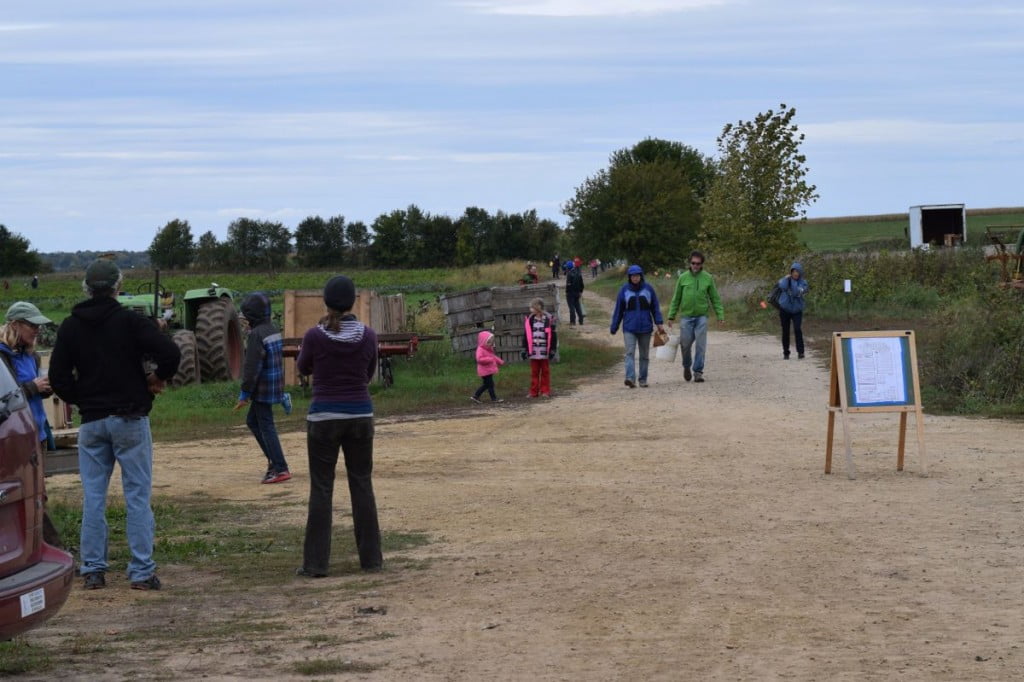
Members wandered across the farm, reaching the furthest corners of the farm. I think Steve included a few distant fields in the gleaning list for just that reason.

It was a family outing for many.
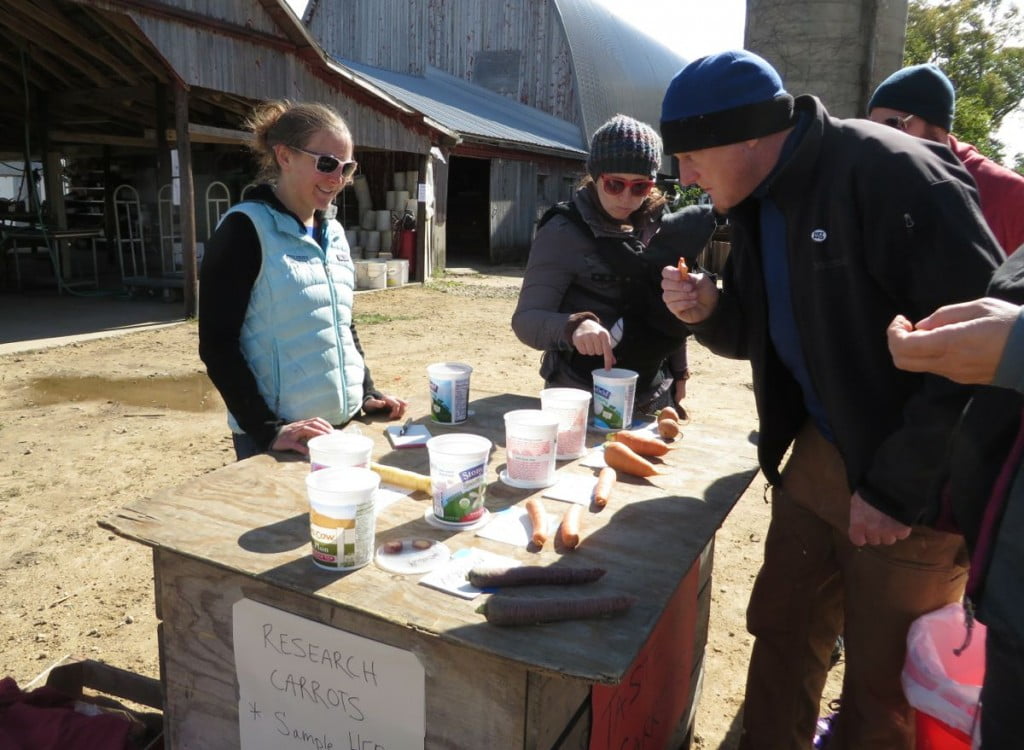
UW graduate student Claire Luby offered samples from her carrot research trial which she just finished harvesting. I’ve written before about Claire and Irwin Goldman’s research plots at our farm.
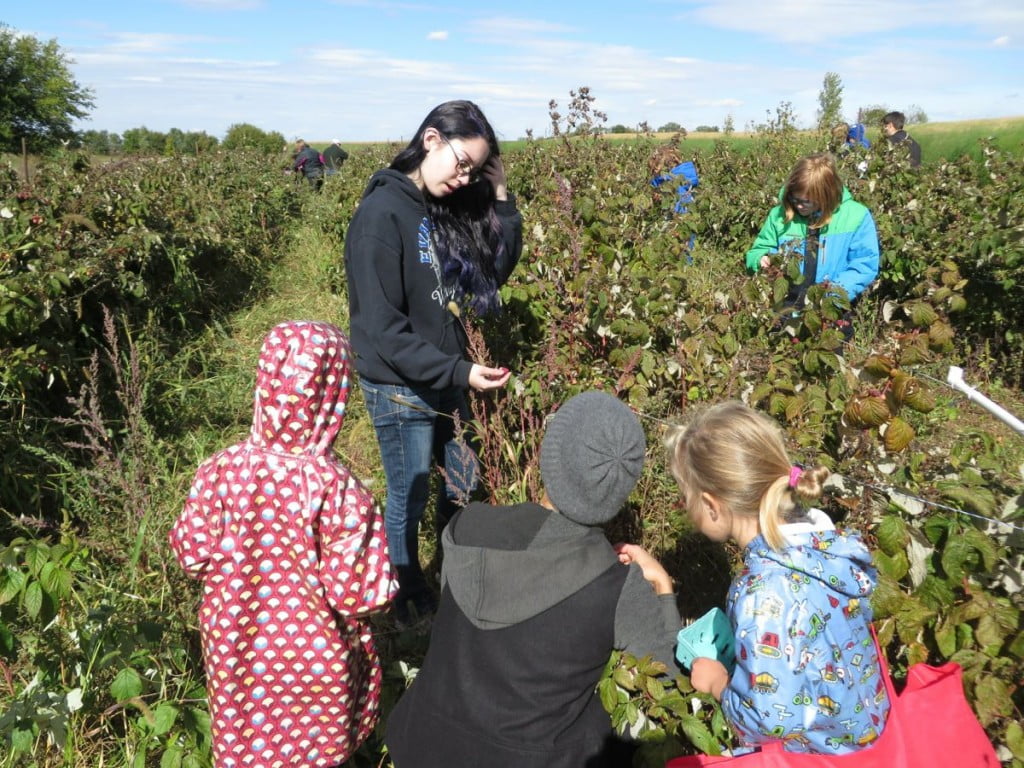
Our daughter taught members how to find good raspberries. The fruit flies are not too bad right now, so persistent (and patient) members could find good berries.
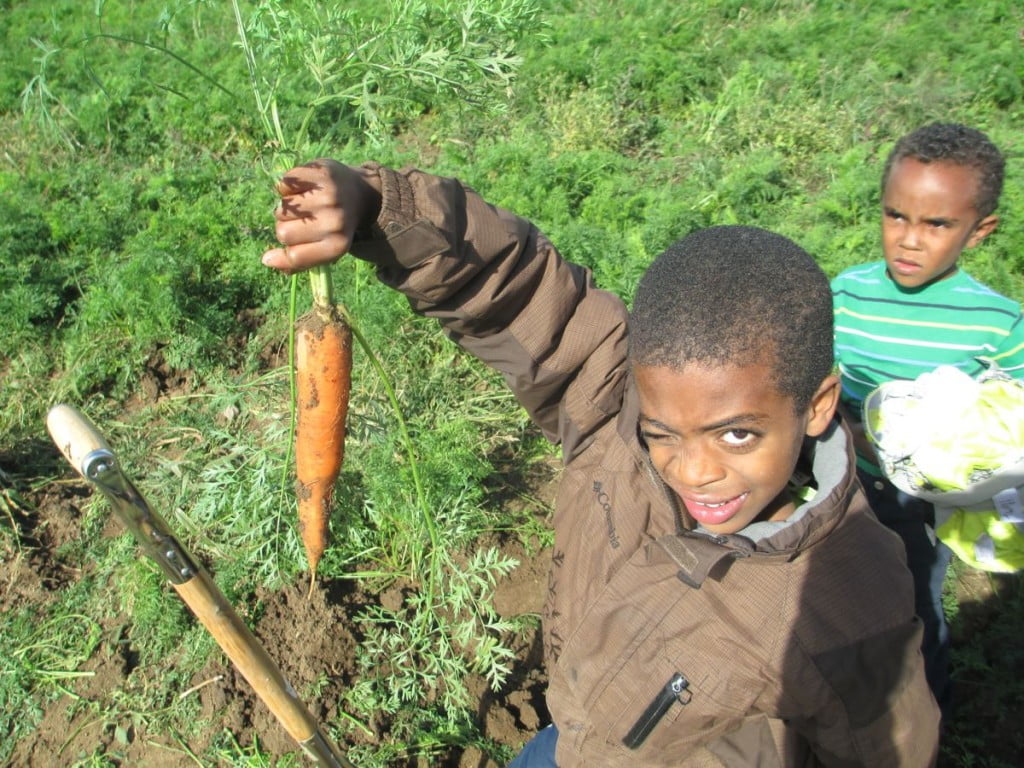
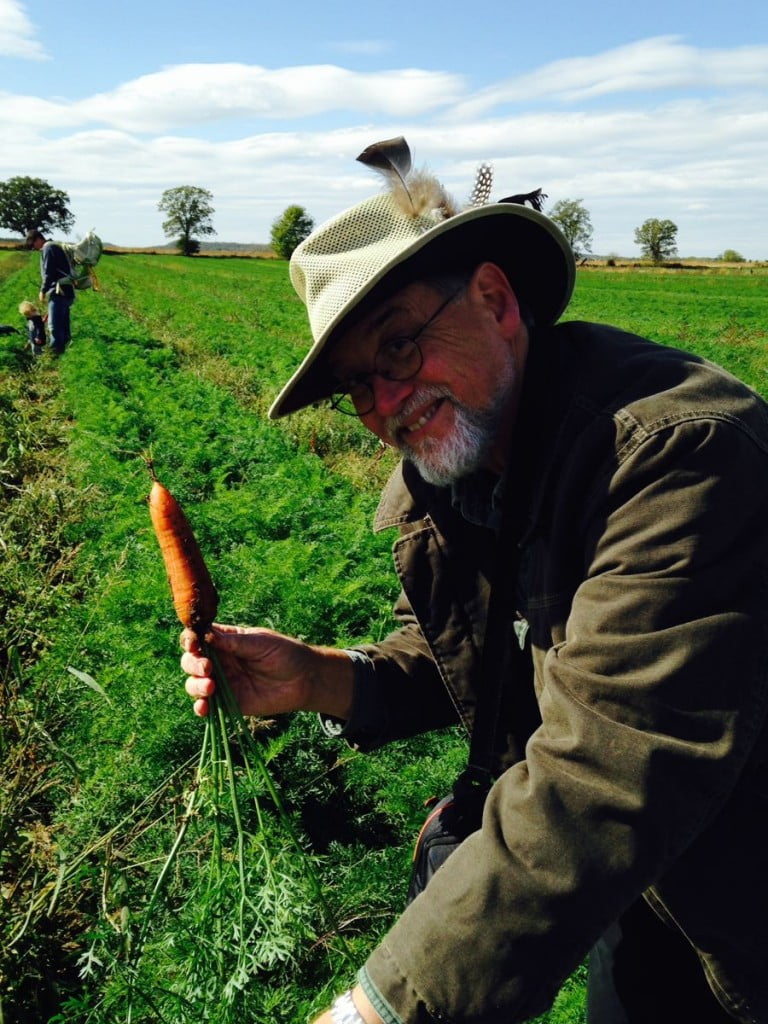
The thrill of digging up a big carrot!
I enjoy seeing our farm through our members’ eyes. Julie Garret took the lovely photos below.
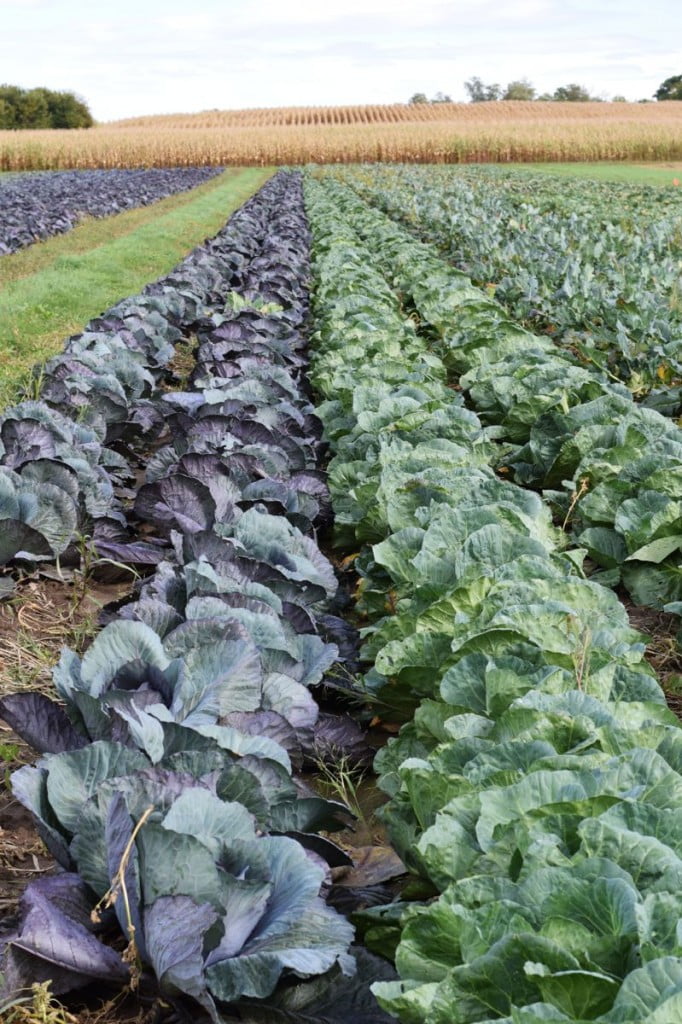
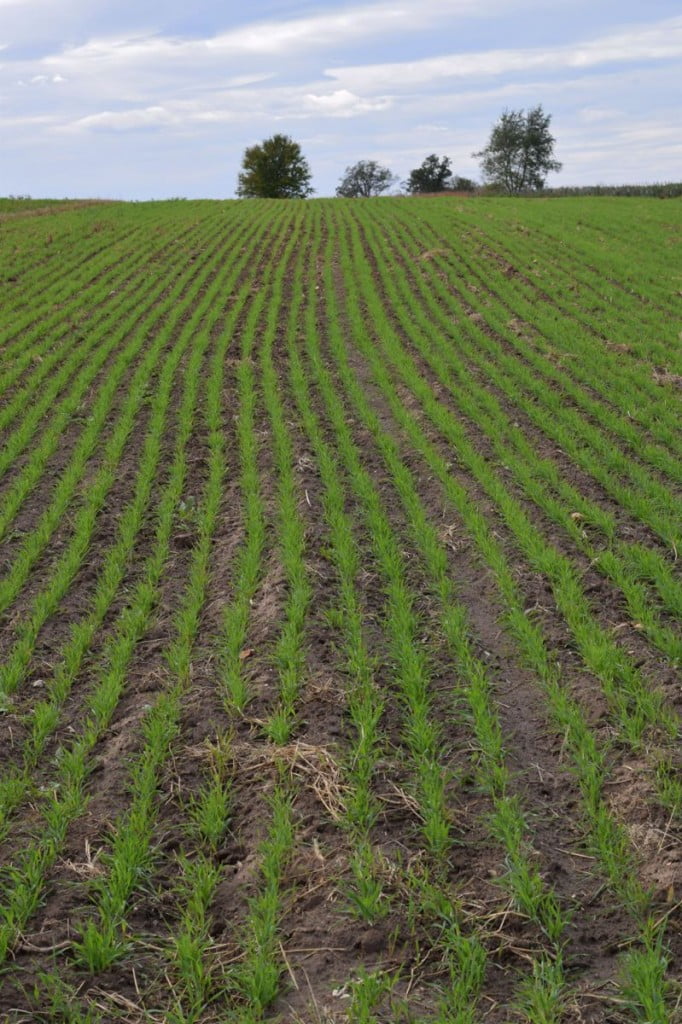
Thanks to everyone who shared their photos with us.
Veggie list and veggie notes (10/9/14, week #21, green EOW)
It’s been a busy week for us. All our winter squash and sweet potatoes are safely harvested. That feels good. I’ll post photos of the harvests next week. We hope you enjoy this pretty box of veggies. Everything is so vibrant right now. We plan to send lots of winter squash in the remaining boxes, especially butternuts which are so versatile for cooking. See below for a favorite butternut recipe.
‘Metro’ butternut squash, 1
Cauliflower
Golden beets with greens, 1 bunch
Eggplant, globe or Japanese
Carrots, 2 lb
Bell peppers, 2
Anaheim chiles (hot), 2
Yellow onions, about 2
Parsley, 1 bunch
Next week’s box will contain winter squash or sweet potatoes, bok choy or cabbage, scallions, garlic, onions, daikon radish, peppers and more.
Butternut squash (tan, long) – These are the ‘Metro’ variety, a favorite because it cures and sweetens quickly after harvest. These are medium-sized squash, average weight 2.0 to 2.5 lb.
Eggplant – We finally have eggplant to share. It has been a difficult year for eggplant due to season-long insect attacks. The plants set a late crop. We’re glad they are ready to harvest before frost. By this time of year, the eggplant may be seedy.
Anaheim chiles (long, slender, red, green or mixed red and green) – These are hot peppers. Anaheims usually have medium spiciness although it varies from pepper to pepper. As usual, the heat is concentrated in the seeds and midveins. Remove the seeds and midveins is to lessen the chili’s heat. Anaheims are easily mistaken for Italian frying peppers. We never send them in the same box for that reason. Keep this in mind if you have frying peppers left over from last week.
Golden beets with greens – Beet greens are delicious. They are similar to Swiss chard in flavor, texture & cooking time (the two crops are very closely related.) You can remove the thickest midribs before cooking if you wish, but it is not essential.
Storage: Cover and refrigerate. The beet roots will last for weeks. Beet greens are perishable and should be eaten soon. Separate the tops and roots if you don’t plan to eat the greens immediately, to preserve freshness in the roots.
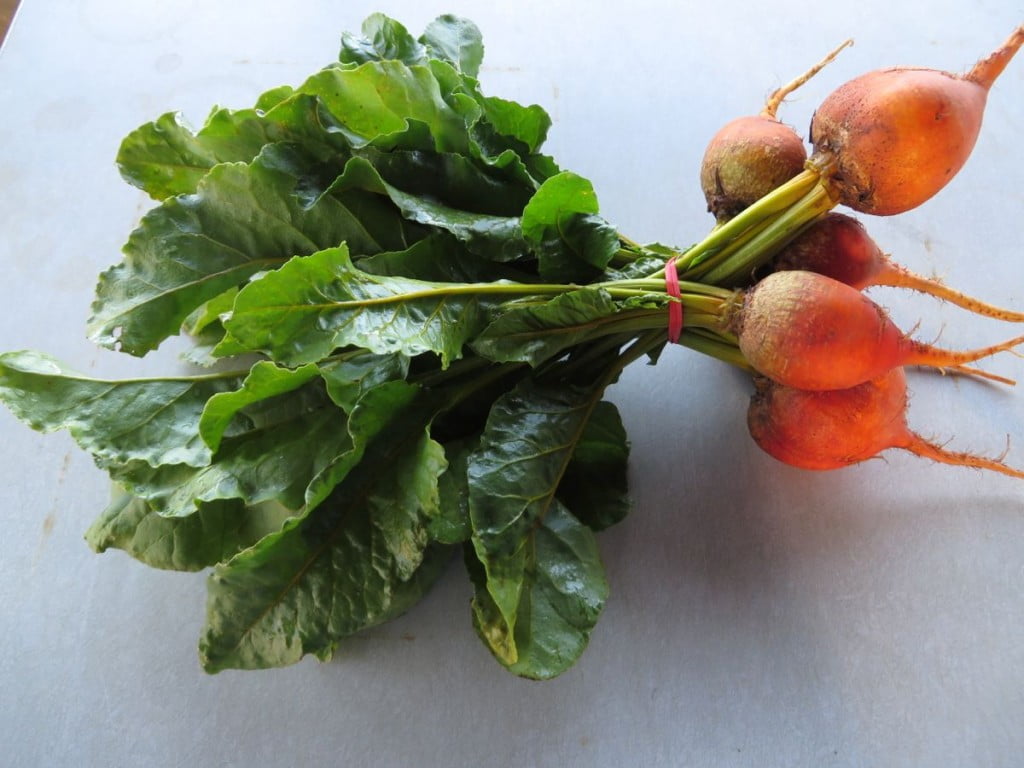
Masala Winter Squash
Mark Bittman, ‘The Best Recipes in the World.’ Serves 4. Time: 40 minutes.
Beth’s notes: This is a lively dish with lots of flavor. It’s OK to skip the tomatoes unless you have a few in the freezer; just add lime juice at the end to replace the acidity. Add the lime juice bit by bit – it doesn’t take much. Serve with rice. Mark Bittman writes this is a “lovely winter stew that can be a centerpiece for vegetarians (or for meat eaters with the addition of a few cubes of boneless chicken).”
1 large onion
5 garlic cloves, peeled
1 small dried chile or 1 tsp hot red pepper flakes, or to taste
2 Tbsp. corn, grapeseed or other neutral oil
salt and black pepper to taste
1 Tbsp. curry powder, or to taste
1 cup chopped tomato (canned is fine), optional
about 1 ½ lb winter squash, like butternut or firm pumpkin, peeled and cut into 1-inch cubes
lime wedges for serving
1. Combing the onion, garlic and chile in a food processor and grind until pasty. Put the oil in a large skillet or flameproof casserole with a lid over medium heat and add the onion mixture along with some salt and pepper and the curry powder. Cook, stirring occasionally, until the onion begins to brown, 5 to 10 minutes.
2. Add the tomato or ½ cup water along with the squash. Cover and adjust the heat so the mixture simmers steadily. Cook, stirring occasionally (and gently) and adding more water if necessary, until the squash is tender, about 20 minutes. Serve with the lime wedges.
Our newest tools
- On: October 01, 2014
 0
0
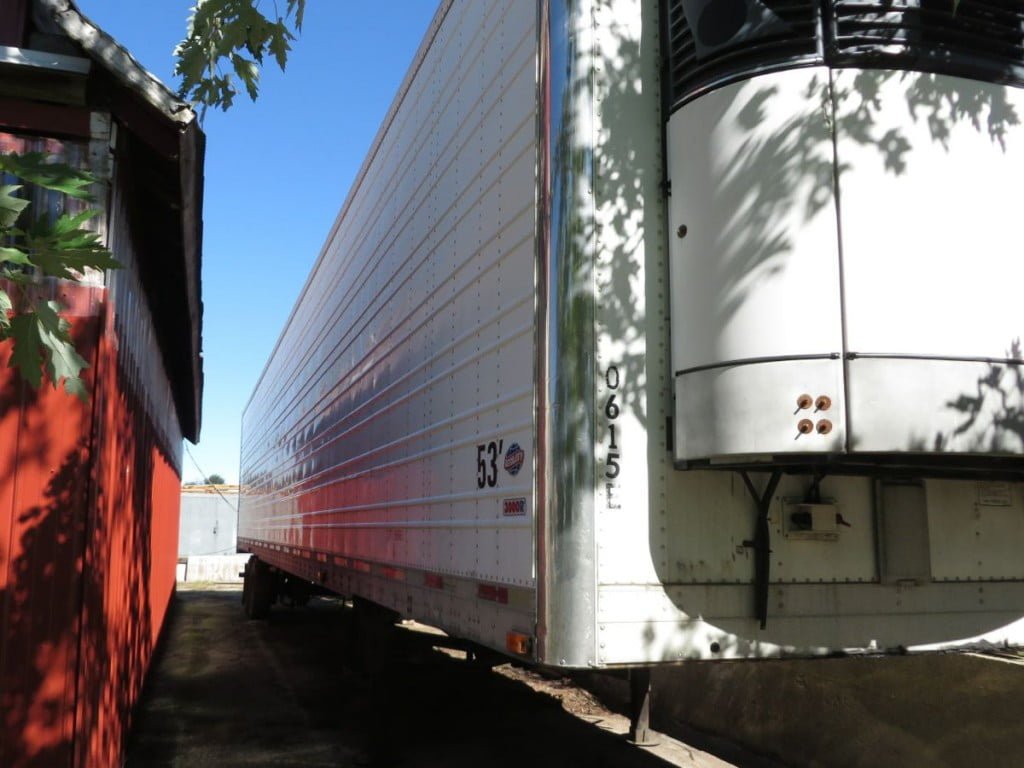
Our own semi-trailer, parked next to our red box barn.
Steve is working to upgrade our root storage and washing before the big fall harvests begin. Our winter root crops look abundant, more than we can fit in our current coolers. Several years ago, we stored part of our carrot crop in a cold storage facility in Madison, but that created transportation hassles. The solution? We bought a used refrigerated semi-trailer that was ready to retire from the road. It’s 53 feet long and can hold about 50,000 lb of roots in big wooden bins. No more running back and forth to Madison to retrieve carrots to wash at the farm, then ship back to Madison. I’ll post photos later this fall as we fill the trailer.
We are also in the midst of upgrading our root washing equipment. This is a big deal for us. We wash and sell 60 to 70 tons of roots through the winter, so our crew appreciates any improvements. Our goals are to ease the physical labor involved, and to find equipment that’s easy to clean. Our newest tool is a barrel washer from a Mennonite group in Pennsylvania. We’ll use it to wash carrots and other roots.
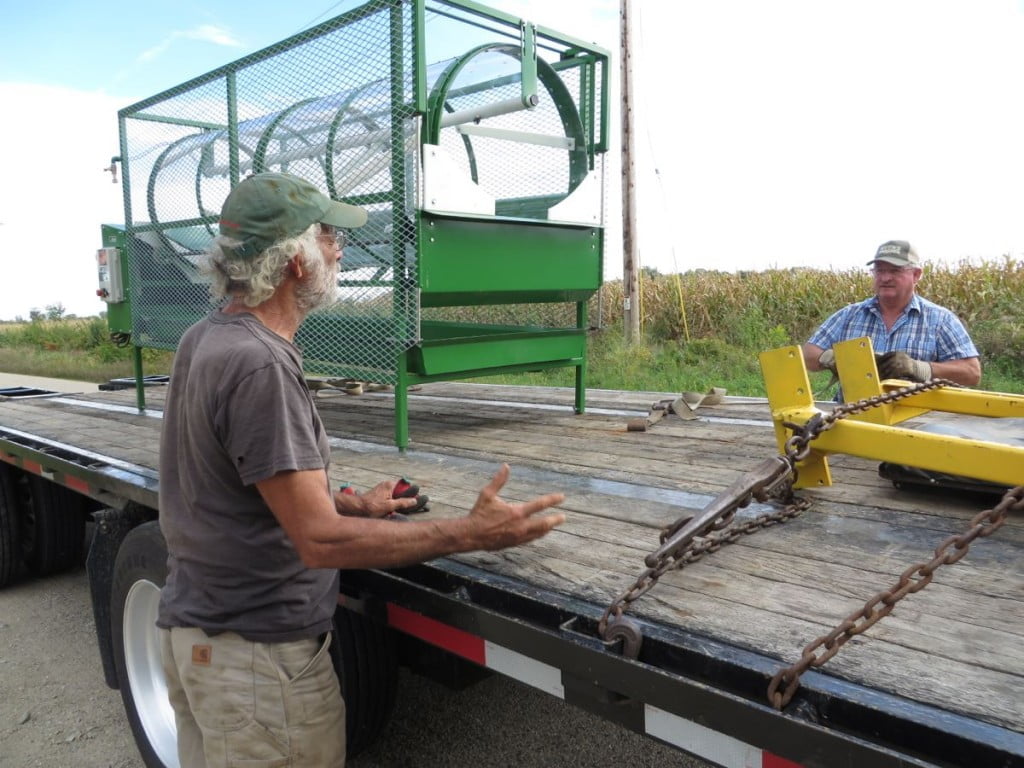
Steve with Mark Roeters who sold us the new barrel washer. They caught up on gossip about who-bought-what new farm equipment. Mark sells and delivers throughout the USA, so he knows everyone’s equipment.
Steve is very absorbed in these preparations. Evolving plans for the new washing setup are scattered in our office and kitchen. His gaze wanders back to the trailer, which keeps popping up in conversation. “You know, that trailer will be great storage for our empty bins. It will really free up space in the barn” or “I might add an extra layer of insulation, just in case.” We don’t have much time before the weather turns cold.
Farm news and Veggie list (10/2/14, week #20, purple EOW)
Our cabbage-family crops are growing strongly. Almost all our broccoli, cauliflower and Romanesco are harvested or will be ready in the next two weeks. This is not normal. Often, the cauliflower and Romanesco barely mature in time for our final CSA deliveries. We’re glad to have these crops for the CSA boxes now, but we have to recognize that we will not have much broccoli, cauliflower or Romanesco in late October and early November.
Yellow potatoes, 3.5 lb
Romanesco broccoli, 1
(We’ll send a broccoli head too if your Romanesco is small)
Acorn squash, 1
Delicata OR Sweet Dumpling squash, 1
Leeks, 2 lb
Carrots, 2 lb
Frying peppers, mixed colors, about 3
Jalapeño chiles, 2
Cilantro, 1 bunch
Garlic
Next week’s box will probably contain cauliflower or Romanesco, winter squash, peppers, onions, carrots and more.
Romanesco broccoli (pale green conical head, possible tinged with purple) – This is one of our prettiest vegetables. Look at it closely to appreciate its branched beauty and repeating spiral pattern. It is called broccoli, but is closely related to cauliflower which it resembles in flavor and texture. Like broccoli and cauliflower, it is fine eaten raw or cooked. It requires cooking times intermediate between the two. Don’t overcook it. I usually steam it, then dress it simply with a butter-lemon-garlic-mustard sauce.
Acorn squash – Acorn squash are mild and benefit from browning the cut surfaces to bring out their flavor. We like to cut acorn squash into slices, then roast or pan-fry the slices until they caramelize. Acorn squash are also good for stuffing. These are ‘Tip Top,’ our favorite acorn squash variety. We have tested many varieties over the past few years, and settled on this one as the best.
Jalapeño chiles (small, dark green or red) – These are hot.

